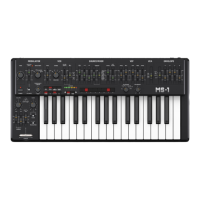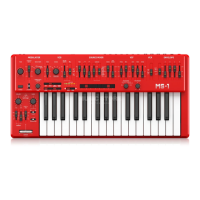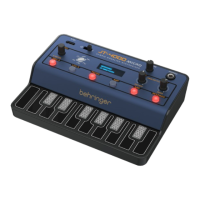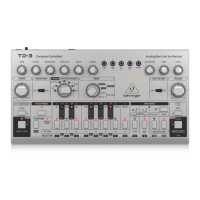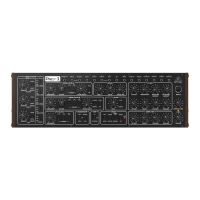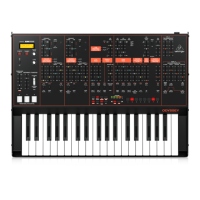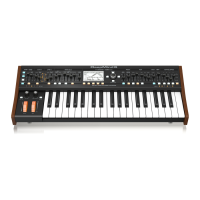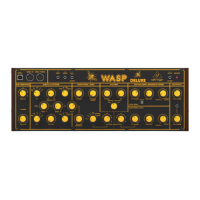Step 2: Controls
1. KEYBOARD – the keyboard has 37 semi-weighted, full-size keys.
2. MG1 WHEEL – adjust the modulation depth from off to maximum. The operation of both wheels can be
adjusted and customized using the WHEEL controls (7).
3. BEND WHEEL – raise or lower the pitch, with a center detent position.
4. KEY ASSIGN MODE – these switches
select how the keyboard is assigned to the synthesizer. (See “Getting Started” for more details.
HOLD – holds all notes played. (Select a KEY ASSIGN switch, before pressing HOLD.) CHORD MEMORY –
play and hold any desired chord in POLY or UNISON/SHARE mode, and then press
CHORD MEMORY. The chord will be memorized and can be played back with a single key press.
UNISON – this monophonic mode plays all the VCOs when playing one key. Each VCO can be adjusted
individually.
UNISON/SHARE – this polyphonic mode automatically shares the number of notes played, among the VCOs
POLY – this conventional polyphonic mode assigns the notes in the playing order to each VCO.
5. EFFECTS ON/OFF – enable/disable the effects produced using the X-MOD/FREQ-MOD/MODE controls (see
item 11 below).
6. ARPEGGIATOR – three switches are used to set up the arpeggiator:
ALL/2OCT/1OCT – selects the octave range. UP/DOWN/UP-DOWN – selects the playback note order.
LATCH/ON/OFF – select LATCH to hold the arpeggio when all notes are released. Select ON or OFF to
engage/disengage the arpeggio. Use the MG2 FREQUENCY knob to adjust the arpeggio tempo. Make sure it is
not on zero when first creating an arpeggio.
7. WHEEL – this section allows you to select the operation and adjust the intensity of the BEND and MG1 wheels.
INTENSITY – adjusts the intensity or effect of each wheel. On zero, the wheels will have no effect.
SELECTOR – select the operation of each wheel:
VC0 1/SLAVE VCOs – the BEND wheel affects VCO1 if the EFFECTS switch is Off. If EFFECTS is On, then it

